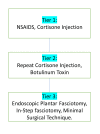Calcaneal Spurs: A Potentially Debilitating Disorder
- PMID: 36185871
- PMCID: PMC9514376
- DOI: 10.7759/cureus.28497
Calcaneal Spurs: A Potentially Debilitating Disorder
Abstract
Feet are often the most neglected part of the body, all the while being the highly dependent part of daily work and mobility. The lack of attention to them can lead to painful conditions such as calcaneal spurs and associated conditions. Calcaneal spurs are bony projections that form around the calcaneal bone, the strongest, most significant, and posterior-most bone in the feet. The classic symptom of the calcaneal spur is talalgia, commonly known as heel pain. There are many causes of heel pain, which are usually associated with calcaneal spurs. Hence it becomes imperative to diagnose and treat them effectively. The development of calcaneal spur is shrouded in mystery, and why a few individuals are more prone to developing the condition than others depends on their gender, age, occupation, and lifestyle. Calcaneal spurs are seen in association with many diseases. It is also regarded as the etiological factor in plantar fasciitis and increasing body weight and as a complication in arthropathies, Gout, pes cavus, and pes planus. This review article aims to highlight a relationship between those factors while also summarizing the treatment modalities present today. Hence, it promotes the usage of a model for administering treatment based on a tier-wise follow-up procedure, where the response to a particular treatment is recorded. If it does not resolve the spur, the treatment progresses to the next tier. This review article hopes to shed light on the understanding and treatment of calcaneal spurs.
Keywords: bony outgrowth; calcaneal spur; calcaneal tuberosity; gout; heel pain; plantar fasciitis.
Copyright © 2022, Velagala et al.
Conflict of interest statement
The authors have declared that no competing interests exist.
Figures



References
-
- History and mechanical control of heel spur pain. Bergmann JN. https://europepmc.org/article/med/2189536. Clin Podiatr Med Surg. 1990;7:243–259. - PubMed
-
- Biomechanics of longitudinal arch support mechanisms in foot orthoses and their effect on plantar aponeurosis strain. Kogler GF, Solomonidis SE, Paul JP. Clin Biomech Bristol Avon. 1996;11:243–252. - PubMed
Publication types
LinkOut - more resources
Full Text Sources
